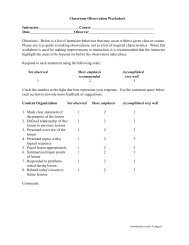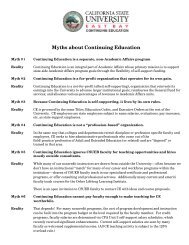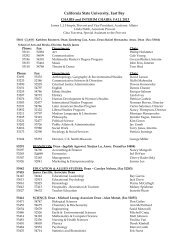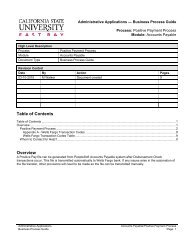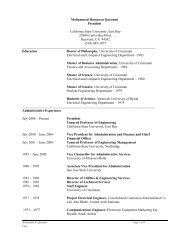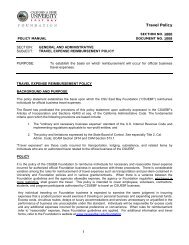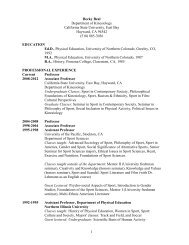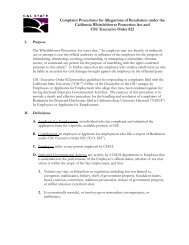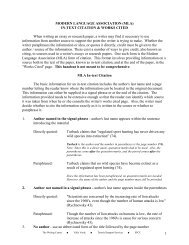Report of the Semester Conversion Task Force - California State ...
Report of the Semester Conversion Task Force - California State ...
Report of the Semester Conversion Task Force - California State ...
- No tags were found...
Create successful ePaper yourself
Turn your PDF publications into a flip-book with our unique Google optimized e-Paper software.
<strong>Semester</strong> <strong>Conversion</strong> <strong>Task</strong> <strong>Force</strong> <strong>Report</strong>Fitting courses into termsTable 1 illustrates some <strong>of</strong> <strong>the</strong> ways in which courses <strong>of</strong> various sizes can fit terms <strong>of</strong> various lengths.When examining Table 1, realize that a consequence <strong>of</strong> separating <strong>the</strong> notion <strong>of</strong> a unit <strong>of</strong> credit from<strong>the</strong> number <strong>of</strong> weeks in a term is that <strong>the</strong> number <strong>of</strong> hours required per week varies with <strong>the</strong> number <strong>of</strong>weeks. For example, one semester unit requires 15 instructional hours. To fit those hours into 15 weeksrequires one hour per week. But one could also put all 15 hours into a single week, or stretch <strong>the</strong>m over5 weeks—which would require 15/5 = 3 hours per week. To fit 15 hours into 10 weeks would require15/10 = 1.5 hours per week. To fit 15 hours into 14 weeks—<strong>the</strong> <strong>Task</strong> <strong>Force</strong> recommendation—requires15/14 = 1.07 hours per week. In Table 1, this is shown as <strong>the</strong> column Instructional hours per week forone unit.Each row in Table 1 represents a different approach to fitting courses into terms.A. This row, a traditional quarter, has 10-week terms and uses quarter units. A quarter unitrepresents 10 instructional hours, delivered at a rate <strong>of</strong> 1 hour per week. A course <strong>of</strong> 4 quarterunits, <strong>the</strong> CSULA standard, requires 4 hours per week.B. This row represents <strong>the</strong> same amount <strong>of</strong> instruction over <strong>the</strong> same period <strong>of</strong> time as row A, butis counted in semester units. Both row A and row B refer to 40 instructional hours—four hours aweek for 10 weeks. Row B counts that amount <strong>of</strong> instruction in semester units. Since 15instructional hours is one semester unit, 40 instructional hours is 40/15 = 2.67 semester units. Ino<strong>the</strong>r words, row B demonstrates keeping <strong>the</strong> current CSULA schedule and catalog exactly as<strong>the</strong>y are but counts credits in semester units. Row B represents <strong>the</strong> simplest possibleconversion. CSULA could convert to semesters by doing nothing but multiplying all unit numbersin <strong>the</strong> catalog by 2/3. Of course, a drawback <strong>of</strong> this approach is that it requires <strong>the</strong> use <strong>of</strong>fractional units. A student might say that she is taking 4 courses for a total <strong>of</strong> 10 2/3 semesterunits. But fractional units add up just as integral units do. The student will graduate when shecompletes her requirements and accumulates 120 semester units.C. This row, <strong>the</strong> traditional 15 week semester, has courses <strong>of</strong> 3 semester-units each, <strong>the</strong> standardagainst which conversion options are generally measured. Most semester courses are 3semester units—or 3 x 15 = 45 instructional hours. To be semester compatible, convertedcourses should primarily be 3 semester units.D. This row, <strong>the</strong> 14 week semester, has become common and is a <strong>Task</strong> <strong>Force</strong> recommendation.Courses <strong>of</strong> three semester units—i.e., 45 instructional hours—consist <strong>of</strong> 14 ra<strong>the</strong>r than 15 weeks.Each semester unit requires 15/14 = 1.07 instructional hours per week.E. This row, like <strong>the</strong> preceding two, delivers all instructional hours in 10 weeks ra<strong>the</strong>r than 15 or 14.Each unit requires 15/10 = 1.5 instructional hours per week. It is an interesting approachbecause it <strong>of</strong>fers <strong>the</strong> possibility <strong>of</strong> three semesters during each regular academic year whileremaining semester compatible.F. This row represents <strong>the</strong> traditional 15 week semester if <strong>the</strong> standard course were 4 semesterunits instead <strong>of</strong> than 3.G. This row is <strong>the</strong> same as <strong>the</strong> preceding except that instruction time is 14 weeks.H. This row is <strong>the</strong> same as <strong>the</strong> preceding except that instruction time is 10 weeks.10



